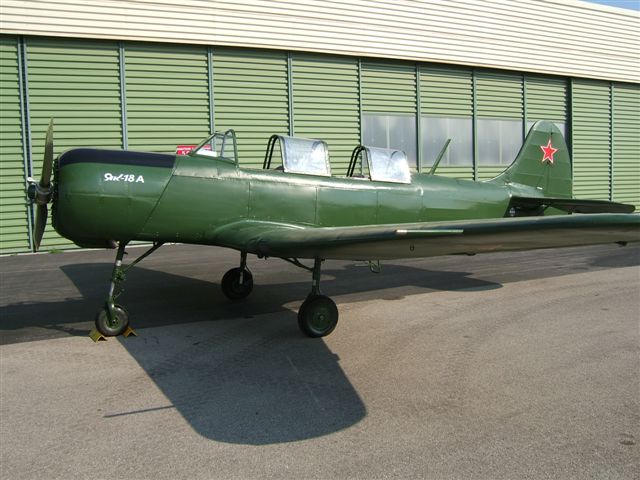The YAK 18A
A member of the second generation of Russian aircraft designers, and best known for fighter designs, Alexander Sergeyevich Yakovlev always retained a light aircraft design section. In May 1945, Yakovlev initiated design of the Yak-18 two-seat primary trainer. He designed it to replace the earlier Yakovlev UT-2 and Yak-5 in service with the Soviet Air Forces and DOSAAF (Voluntary Society for Collaboration with the Army, Air Force and Navy, which sponsored aero clubs throughout the USSR). In 1944, an advanced version of the UT-2 had been built and featured an enclosed canopy and fixed landing gear which bears a striking resemblance to the new Yak-18. The new aircraft flew a year later, powered by a 119 kW (160 hp) Shvetsov M-11 five-cylinder radial engine and featuring pneumatically operated retractable main landing gear and a fixed tailwheel. It entered service as a trainer later that year and was built by Yakovlev up until 1956. Examples were exported to China in kit form beginning in 1950. The Chinese then went on to redesign the aircraft with the designation CJ-5.
The Yak 18’s greatest claim to fame is its use as a night bomber by the North Korean Air Force during the Korean War. The aircraft were modified with bomb racks on the wing center section and flew over UN troop locations at night to drop bombs and harass UN forces. The single most successful attack of the North Korean aviation during the war was destroying of a fuel dump with nearly 5.5 million gallons of fuel in Inchon area in June 1953 by 4 or 5 Yak-18s. The five-cylinder engine reminded many of the US troops of the sound made by early gasoline powered washing machines earning them the name: “Washing Machine Charlie”. The name “Bed Check Charlie” was also used for these night intruders. The Yak-18’s along with Polikarpov Po-2‘s became quite a nuisance until US night fighters began shooting them down.
Other claims to fame for the Yak-18 are an international speed record for class in 1951 as well as being the aircraft used for initial flight training by Yuri Gagarin (1st human in space) and Ken Rowe (No Kum-Sok: defected with a Mig-15 during the Korean War). Later, as the need for conventional landing gear trainers abated Yakovlev re-designed the Yak-18 with retractable tricycle landng gear and an Ivchenko AI-14RF radial, 224 kW (300 hp) and was designated the Yak-18A. The design proved exceptionally easy to build and maintain.
There are an estimated 40 original Yak-18’s in existence worldwide. Five are currently flyable in the USA, three are flyable in Europe, and the Chinese Air Force has one flyable with several other airframes in storage. Approximately four other aircraft worldwide are currently being restored for flight. Many are found in major aviation museums worldwide including the National Air and Space Museum in the USA. The CJ-6a, produced in China, is sometimes quoted as a variant but is a completely different aircraft designed in China by Bushi Cheng and built by Nanchang Aircraft Company.

